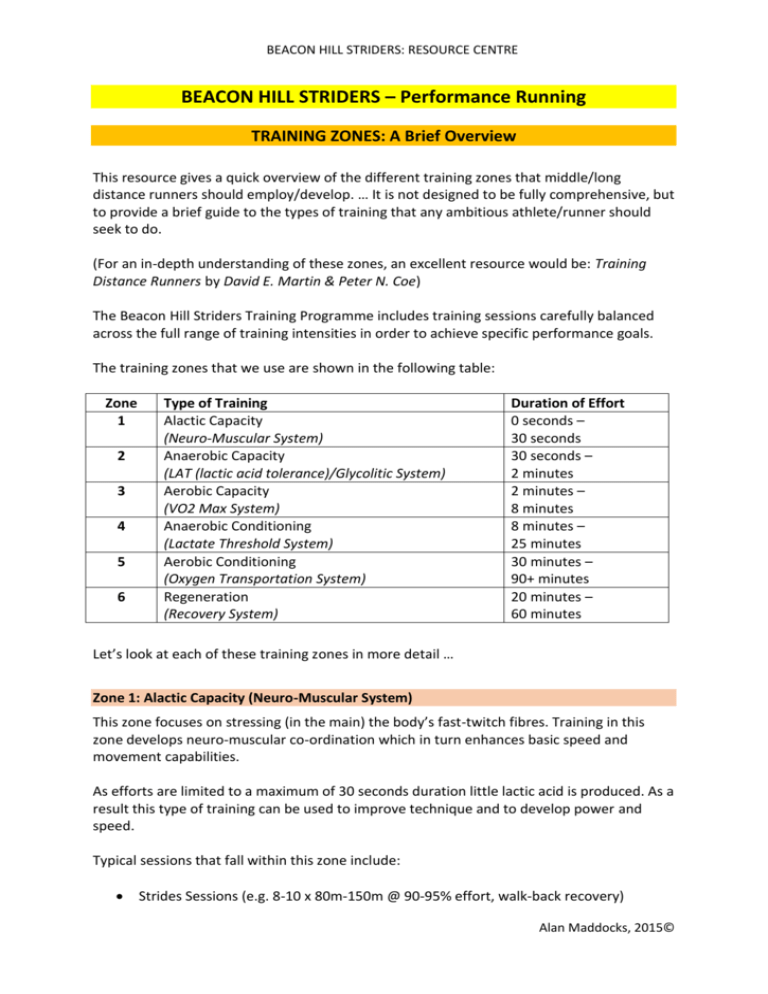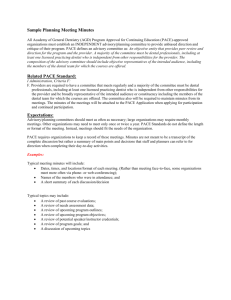Training Zones - Beacon Hill Striders
advertisement

BEACON HILL STRIDERS: RESOURCE CENTRE BEACON HILL STRIDERS – Performance Running TRAINING ZONES: A Brief Overview This resource gives a quick overview of the different training zones that middle/long distance runners should employ/develop. … It is not designed to be fully comprehensive, but to provide a brief guide to the types of training that any ambitious athlete/runner should seek to do. (For an in-depth understanding of these zones, an excellent resource would be: Training Distance Runners by David E. Martin & Peter N. Coe) The Beacon Hill Striders Training Programme includes training sessions carefully balanced across the full range of training intensities in order to achieve specific performance goals. The training zones that we use are shown in the following table: Zone 1 2 3 4 5 6 Type of Training Alactic Capacity (Neuro-Muscular System) Anaerobic Capacity (LAT (lactic acid tolerance)/Glycolitic System) Aerobic Capacity (VO2 Max System) Anaerobic Conditioning (Lactate Threshold System) Aerobic Conditioning (Oxygen Transportation System) Regeneration (Recovery System) Duration of Effort 0 seconds – 30 seconds 30 seconds – 2 minutes 2 minutes – 8 minutes 8 minutes – 25 minutes 30 minutes – 90+ minutes 20 minutes – 60 minutes Let’s look at each of these training zones in more detail … Zone 1: Alactic Capacity (Neuro-Muscular System) This zone focuses on stressing (in the main) the body’s fast-twitch fibres. Training in this zone develops neuro-muscular co-ordination which in turn enhances basic speed and movement capabilities. As efforts are limited to a maximum of 30 seconds duration little lactic acid is produced. As a result this type of training can be used to improve technique and to develop power and speed. Typical sessions that fall within this zone include: Strides Sessions (e.g. 8-10 x 80m-150m @ 90-95% effort, walk-back recovery) Alan Maddocks, 2015© BEACON HILL STRIDERS: RESOURCE CENTRE Short Hill ‘Sprints’ (e.g. 8-10 x 8-12 seconds @ 95-100% effort, slow walk-back recovery) Accelerations (e.g. 6-8 x 6-8 seconds with flying starts) Speed Endurance Repetitions (e.g. 4-6 x 250m @ 90-95% effort, with ample recovery) “Diagonals” (e.g. 20 minutes of striding diagonally – at 85-90% effort - across football pitch – corner to corner – jogging along the goal-line: a favourite session of Kenyan athletes). Alactic capacity training should be included on a regular (weekly) basis to maintain neuromuscular capacity and speed co-ordination. Zone 2: Anaerobic Capacity (LAT/Glycolitic System) This zone involves repetitions of fast efforts (90-95% effort) ranging from 30 seconds to 90 seconds duration, usually with a specified “recovery” or “interval” between efforts. This involves using both fast-twitch & ‘intermediate’ fast-twitch muscle fibres. Training in this zone involves the production of lactic acid over and above the body’s capacity to re-generate this as fuel. Training is designed to “teach” the body (muscles and cardio-vascular system) to tolerate or buffer the acidosis produced. There are no typical sessions as the permutations are endless. But the following types of sessions would fall within this zone: 8-10 x 200m (or 30 seconds) @ 95-98% effort (with 60 seconds jog/walk recovery) 5-6 x 300m (or 45 seconds) @ 95-98% effort (with 3 minutes recovery) 4-8 x 400m (or 60 seconds) @ 95-98% effort (with 2-4 minutes recovery) Training in this zone is highly stressful and should only be undertaken with great care. Too much training in this zone can easily lead to “overtraining” and a fall in performance capacity. Zone 3: Aerobic Capacity (VO2 Max system) This zone involves repetitions of longer efforts (usually ranging from 2 minutes to 8 minutes) at a specified pace that is close to (but no faster than) VO2 Max pace. (VO2 Max pace – depending on performance capacity – is marginally quicker than 3000m race-pace). Training in this zone taxes both ‘intermediate’ a slow-twitch type muscle fibres. It involves working with both the Aerobic & Anaerobic systems, placing particular stress on the Aerobic system. Training in this zone involves the production - but crucially also the recycling of - lactic acid as an energy source/fuel. Working in this zone mirrors race-pace efforts for those who run the longer “middle” distances (3000m & 5000m). Typical sessions that fall within this zone include: 6-8 x 800m (or 2 minutes) @ 3K pace (2-3 minutes recovery) Alan Maddocks, 2015© BEACON HILL STRIDERS: RESOURCE CENTRE 4-5 x 1200m (or 4 minutes) @ 5K pace (2-3 minutes recovery) 5-6 x 1600m (1M) @ 5K-8K pace (90 seconds – 2 minutes recovery) 3-4 x 2000m @ 8-10K pace (90 seconds recovery) Training in this zone is very effective for all runners competing in events ranging from 1500m to 10000m/10K. Similar to Zone 2 type training, working within this zone should be carefully monitored, and ample (3-4) easy/recovery days should follow such sessions. Zone 4: Anaerobic Conditioning (Lactic Threshold – LT - system) This zone involves continuous running (usually up to 25-30 minutes in total) at or near to the Lactate Threshold. This zone taxes in the main slow-twitch type muscle fibres, though intermediate muscle fibres may also be marginally activated. It involves working towards the high end of the aerobic system at a level where any lactate produced can be resynthesises as a fuel. The pace that tends to equate with Lactate Threshold is the best effort pace for around 60 minutes worth of running (so 10 mile to Half-Marathon race pace for good class male road runners). The main benefit/goal of working at (or just above/below) Lactate Threshold pace is to improve ‘running economy’, and is reflected over time in the Lactate Threshold pace getting quicker. Typical sessions that fall within this zone include: 20-25 minutes continuous running @ LT pace 2 x 12 minutes @ LT pace (short jog recovery) 3 x 8 minutes @ LT pace (90 seconds jog recovery) Training in this zone is often referred to as ‘Tempo Running.’ For younger athletes (nonseniors) this type of running is best conducted in “interval” format (e.g. 2-3 x 8 minutes). Zone 5: Aerobic Conditioning (Oxygen Transportation system) This zone involves continuous running at a relatively relaxed pace for anywhere between 30 minutes and 2 hours. This involves almost exclusively slow-twitch muscle fibres, and correspondingly stresses the Aerobic system only. Training in this zone will form the bulk of the training load for runners specialising in events from 5000m upwards. Training in this zone can (& should) be done on a daily basis. Training in this zone is often referred to as “steady” running and is best done on a continuous (rather than interval) basis. Zone 6: Regeneration (Recovery system) This zone involves very easy continuous running and is often referred to as “jogging”. This easy pace may be used to warm-up (before) & cool-down (after) more intense training sessions, but may indeed form a “training session” or run on its own. For those who train twice a day, the easier run should be focused on “recovery” and this specific zone. Zone 6 runs may be as short as 15-20 minutes, and hardly ever exceed 60 minutes. Alan Maddocks, 2015© BEACON HILL STRIDERS: RESOURCE CENTRE A ‘Balanced’ Training Programme: The goal of planning and designing a training programme for any individual athlete/runner is to provide a balanced programme that matches the strengths/weaknesses and preferences of the athlete with the demands of the chosen specialist event. An 800m runner is unlikely (& indeed should not) train the same way as a Marathon runner. Nevertheless, whether preparing for the 800m or the Marathon - or anything in between all six training zones should be employed, though the balance will be different during the season/year. The art is to discover and provide the perfect balance for each athlete/runner. For further information on how this balance might be achieved, please refer to the following resources that I have also developed: * Balanced Training: The Key to Optimal Performances (http://beaconhillstriders.co.uk/training-group/training-model/) * How Elite Athletes Train (The 80-20 Approach) (http://beaconhillstriders.co.uk/resource-centre/bhs-resources/) Should you wish to receive specific/personal advice and guidance on forming a balanced training programme, you are welcome to E-mail me directly: Alan Maddocks E-Mail: striders1@hotmail.co.uk Alan Maddocks, 2015©





